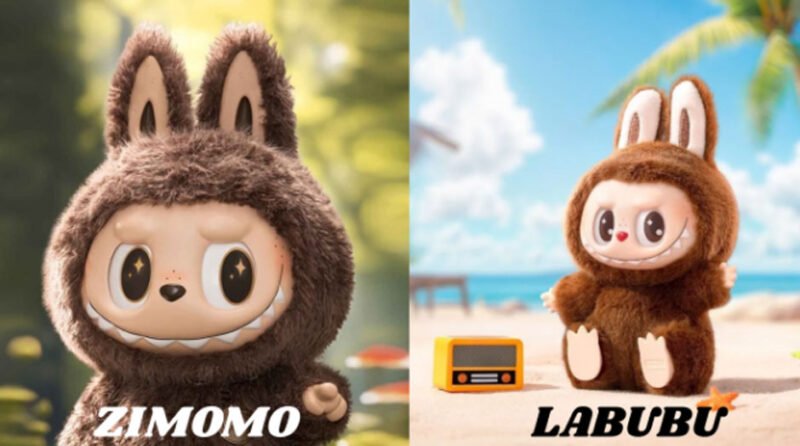The realm of collectible designer toys has discredited with cute characters that capture hearts and wallets alike. Two names that frequently pop up in collector circles are Labubu and Zimomo. While both powers look equally cute and mysterious at first glance, these figures have distinct inceptions, designs, and cultural importance that set bureaucracy separate.
Whether you’re an experienced connoisseur or just offset to survey the designer toy universe, understanding the differences between these well-known individualities can help you make conversant selections about which individual deserve a spot on your jutting.
What is Labubu?
Labubu is a wicked elf-like figure created by Hong Kong artist Kasing Lung. First introduced in 2015, this pointy-eared beast quickly became a perception in the designer toy community. Labubu is popular for its unique features: large sharp ears, small beady eyes, and a somewhat impish expression that desires it’s up to no good.
The individuality belongs to a larger universe called “The Monsters,” where Labubu shows curiosity and playfulness. Pop Mart, the Chinese toy association, has been the basic manufacturer behind Labubu’s commercial gain, releasing countless variations through blind box collections, cooperations, and limited editions.
Labubu figures typically range from 2 to 12 inches in altitude, with the most coarse blind box versions weighing around 2.75 inches. The character has appeared in numerous ideas, from seasonal collections to cooperations with major brands like Crocs and even indulgence fashion houses.
What is Zimomo?
Zimomo takes an entirely different approach to cuteness. Created by Chinese inventor Liu Yingchao, Zimomo is a white, spot-like character that incorporates simplicity and zen-like quiet. The name “Zimomo” translates to “irregular” or “odds and ends” in Chinese, reflecting the type’s complacent, pliable traits.
Unlike Labubu’s wicked energy, Zimomo represents harmony, contentment, and residing in the moment. The type usually performs as a round, soft-expecting figure with slightest first features—often just plain dots for eyes and a small bowed line for a mouth.
Whether you’re an experienced collector or just compensated to explore the creator toy cosmos, understanding the differences between these popular characters can help you devise informed selections about those that earn a spot on your jutting.
What is Labubu?
Labubu is a mischievous elf-like character built by Hong Kong artist Kasing Lung. First introduced in 2015, this pointed-eared creature quickly enhanced a sensation in the creator toy community. Labubu is known for allure distinctive features: abundant pointed ears, small beady eyes, and a fairly impish expression that suggests it’s up to worthless.
The character belongs to a larger universe called “The Monsters,” where Labubu represents curiosity and playfulness. Pop Mart, the Chinese toy company, has been the basic manufacturer behind Labubu’s marketing success, releasing innumerable variations through blind box collections, cooperations, and limited editions.
Labubu figures usually range from 2 to 12 inches in height, with ultimate common blind box versions weighing around 2.75 inches. The character has appeared in numerous ideas, from seasonal collections to cooperations with major brands like Crocs and even luxury fashion houses.
What is Zimomo?
Zimomo takes an entirely different approach to cuteness. Created by Chinese inventor Liu Yingchao, Zimomo is a silver, drop-like character that represents simplicity and zen-like peace. The name “Zimomo” changes roughly to “uneven” or “this and that” in Chinese, reflecting the figure’s permissive, go-with-the-flow traits.
Unlike Labubu’s wicked energy, Zimomo represents harmony, contentment, and reside the moment. The individual usually performs as a round, delicate-anticipating figure with slightest first features—often just simple dots for eyes and a narrow bent line for a mouth.
Zimomo figures are usually produced in easier materials or designed to look luxurious and huggable, even when made from vinyl. The type frequently appears in meditation poses, sleeping positions, or committed in simple, calming projects.
Key Differences Between Labubu and Zimomo
Design Philosophy
Labubu embraces complexity and personality through its itemized features, sharp ears, and expressive face. Every Labubu figure tells a tale through its pose, appearances, or themed outfit. Zimomo, on the other hand, celebrates minimalism. Its plain, round design focuses on evoking feelings of calm and comfort alternatively narrative complexity.
Cultural Background
While both characters originate from Chinese-talking regions, they show different aspects of existing Asian pop culture. Labubu taps into the ethic of mischievous folklore beasts, similar to Japanese yokai or Chinese sprites. Zimomo indicates modern urban education’s desire for mindfulness and simplicity among busy lifestyles.
Collectibility and Market Presence
Labubu has achieved massive marketing success through Pop Mart’s dispersion network, with regular releases, collaborations, and international chance. The character appears in blind boxes, big figures, and even lifestyle crops. Zimomo maintains a more niche ghost, often appealing to collectors who favor understated design and philosophical wisdom over flashy variations.
Price Points
Generally, Labubu figures span a wider price range due to their variety. Blind box Labubu figures usually cost between $10-15, while best or limited editions can reach hundreds of greenbacks. Zimomo figures tend to have more consistent fixing, usually varying from $15-50, with special editions sporadically commanding higher prices.
Which Should You Choose?
Your choice between Labubu and Zimomo ultimately depends on which you value in a collectible integrity. If you enjoy detailed designs, narrative elements, and the thrill of hunting for exceptional variants, Labubu offers endless possibilities. The character’s widespread availability also makes it easier to find distinguishing pieces or trade with other hobbyists.
If you prefer minimalist aesthetics, calming presence, and characters that double as table companions for meditation or stress remedy, Zimomo might be your perfect counterpart. These figures work well as standalone pieces and don’t require thorough knowledge of variations or storylines to enjoy.
Building Your Collection
Both Labubu and Zimomo have passionate hobbyist communities online, making it smooth to find information about releases, trading space, and authentication tips. Many collectors indeed enjoy both characters, appreciating how they serve different characters and display purposes.
Consider starting with individual or two figures from each line to see that it resonates more with your individual taste and collecting style. Remember that the happiness of collecting comes from selecting pieces that really bring you happiness, although advertisement flows or rarity.









